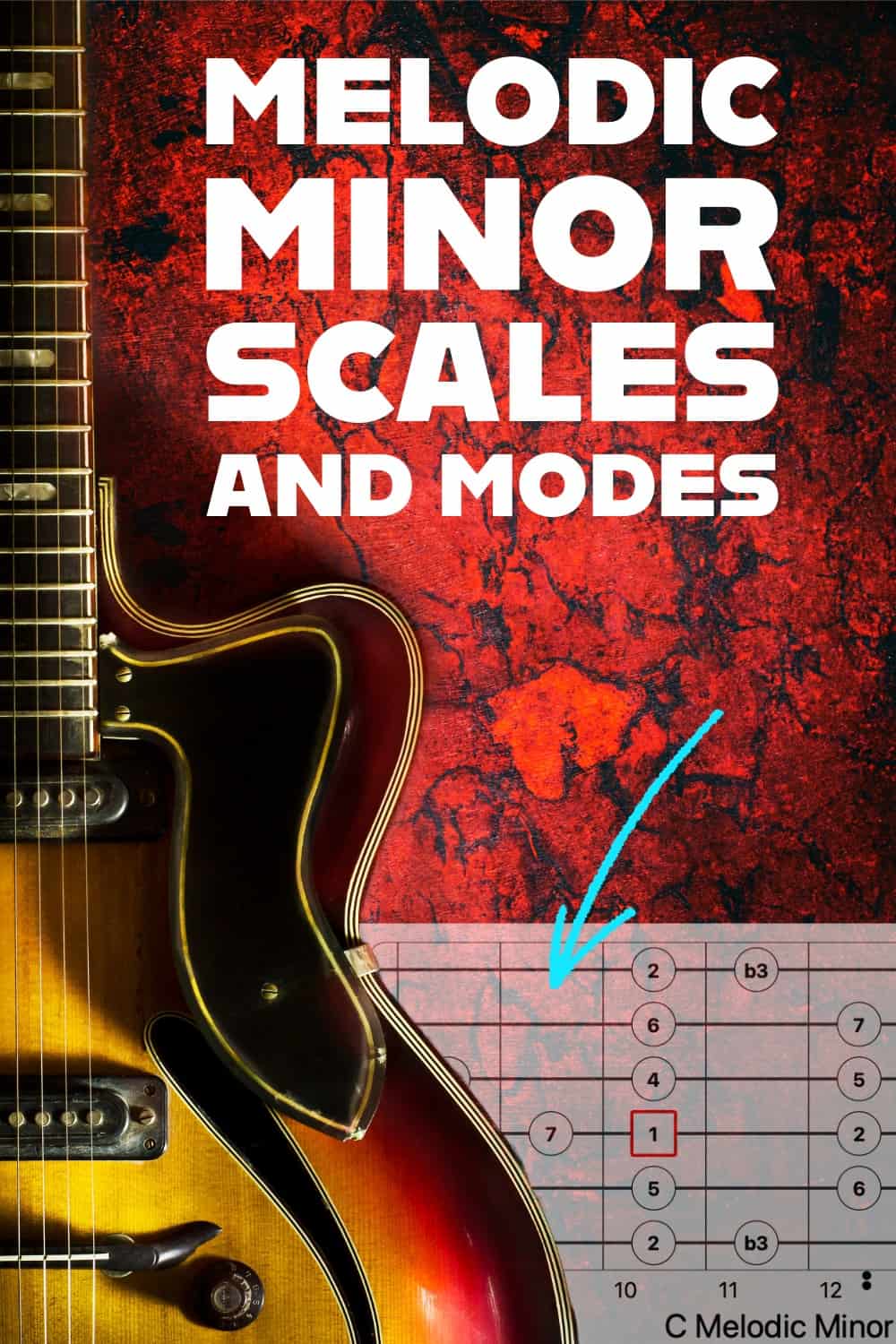Melodic Minor Scales for Guitar
Oh scary isn’t it! The red-headed step-child of minor scales.. unless you’re a Jazz or Classical player that is. The Melodic Minor scale, also referred to as the Jazz Melodic minor scale. Let’s get our hands wrapped around some Melodic Minor Scale and modes for Guitar in this lesson. Updated for 2024, I’ve also included a 3 notes per string Melodic minor scale and modes PDF for guitar at the end of the lesson.
If you’re a rock, metal, blues or country player you probably avoid this scale like the plague.. if you’ve ever even learned it at all. What is the big deal? Why is this scale so misunderstood (and avoided) outside of Jazz?
I was warming up for my gig on a chilly Wednesday afternoon and was jamming along with some backing tracks on YouTube. During weeks when I have a busy gig schedule, I’ve found that often times an hour or so with some backing tracks is as good a practice as a more technical routine, without taxing my hands too much for the night’s gig.. so that’s what I did.
Today I was working with Melodic minor backing tracks and it gave me the idea for this article.
Melodic Minor in Classical Music
Melodic Minor historically was always taught as different ascending than descending. Let’s take a look at an example of that.
Let’s start with our Parent Major Key, in this case, C:
C
D
E
F
G
A- Relative minor
B
C
Starting on the 6th degree (A) We’ll build our Natural minor (or Aeolian mode):
A B C D E F G A
In classical music well into the 20th century Melodic minor ascending raised the 6th and 7th degrees like this:
A B C D E F# G# A
Descending we would lower those notes back to the natural minor:
A G F E D C B A

That’s exactly how my high-School Music Theory teacher Mrs. Bergstrom taught it to me waaaaay back in 1987!
Examples of the Melodic Minor Scale in Classical Music
Probably my favorite classical example… and one just about everyone should be familiar with, is Tchaikovsky’s Nutcracker excerpt.. (more recently popularized by the Trans Siberian Orchestra)
Since I’m writing this at Christmas time, it seems like a fitting example. Let’s take a look:

You can also find lots of Melodic Minor examples in the music of Bach, Scarlatti, S.L. Weiss and other Baroque Era composers.
The Segovia Scales
Andres Segovia, arguably the most influential and important Guitarist of the 20th Century, taught Melodic minor this way in his 1953 scale book.
Here’s an excerpt from the very first page of his classic book. The first scale is a C Major Scale in 2 positions. The second scale is A Melodic Minor ascending in 3 octaves and A Natural Minor descending.
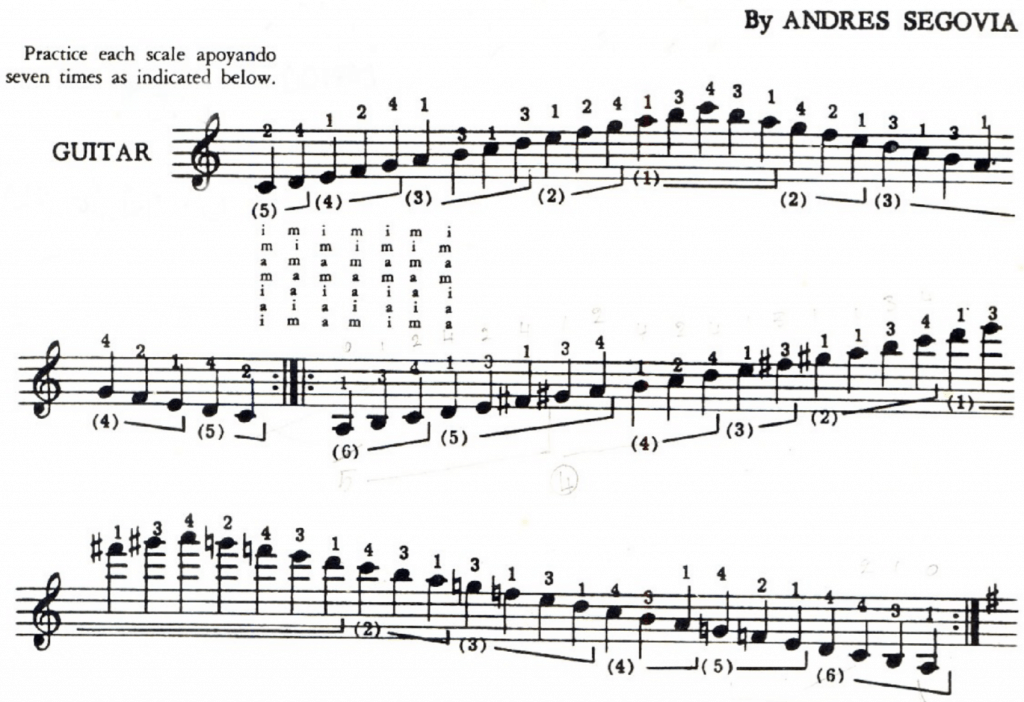
It’s an awkward scale to play and memorize for sure. Take your time and proceed slowly. Pay special attention to the left hand shifting.
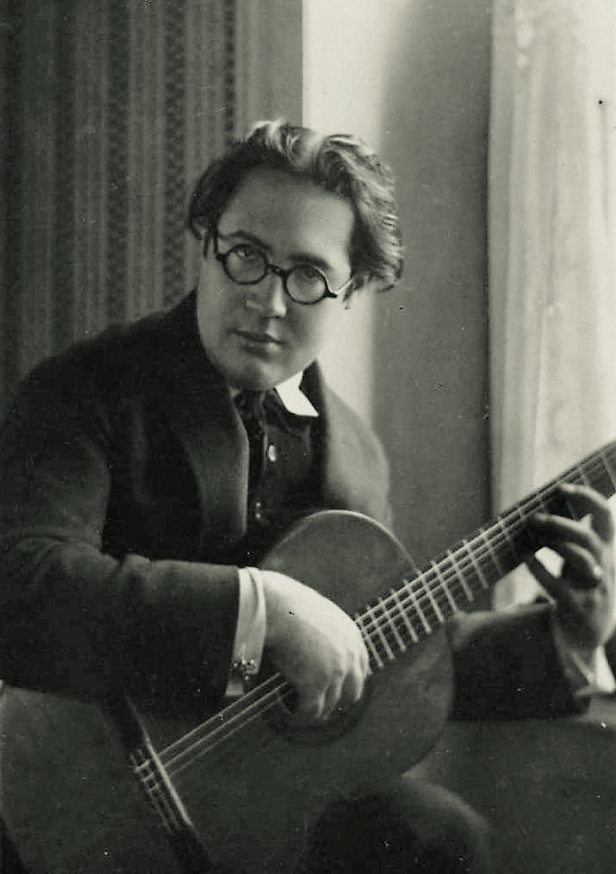
I highly recommend his book even if you’re not into Classical Guitar music as he presents some left hand shifts that are useful and not often taught by modern guitar instructors.
'In one hour of scales may be condensed many hours of arduous exercises which are frequently futile. The practice of scales enables one to solve a greater number of technical problems in a shorter time….' - Andres Segovia | 1953Click To TweetJazz Melodic Minor
Melodic Minor in the 20th Century and Beyond. Somewhere along the line in the early days of Jazz and Bebop music, musicians started to find other uses for Melodic Minor as a more fixed formula that stayed the same both ascending and descending.
As a formula, it really couldn’t be easier. Take your original C Major Scale and lower the 3rd a 1/2 step:
C D Eb F G A B C
C Melodic Minor!
Also commonly referred to as “Jazz Minor”, this scale is widely used primarily in jazz improvisation.
Melodic Minor Scale Formula
If formulas make more sense for you, just think of the melodic minor scale formula as:
1 -2 -b3 -4 -5 -5 -7
You may be thinking.. “Ok great but what the heck do I do with it? Who uses this stuff?”
My favorite non-Jazz example of Melodic minor is in Journey’s classic song “ Stone In Love” off of 1981’s Escape album. It’s probably no coincidence that this was one of my first cassette tapes when I was a kid and it has gone on to become one of my all-time favorite Rock Albums. It’s definitely a classic and contains stellar playing by Neal Schon throughout.
Melodic Minor Scales for Rock Guitar
Toward the end of the song before the big solo build up there’s an odd change to the existing G, D, C, G/B chord structure.
Neal Schon comes in after the build-up with this soaring solo in C Melodic minor:
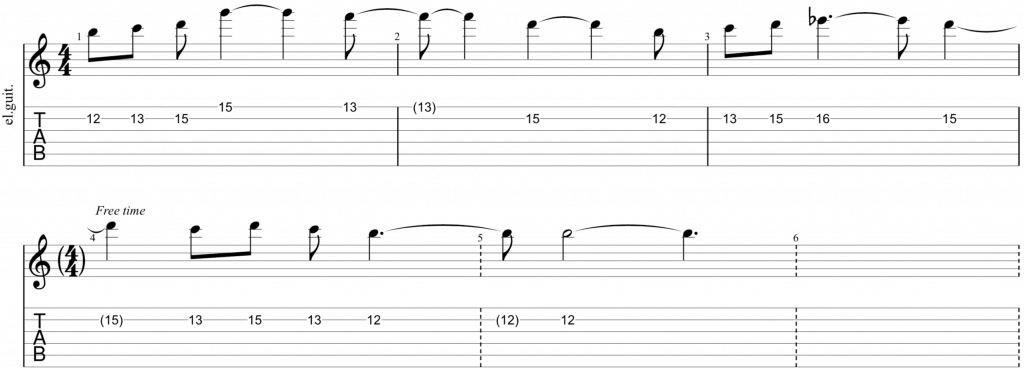
Notice in the above example there is no change to the scale ascending or descending. It’s the same notes in either direction:
C D Eb F G A B C
Melodic Minor Guitar Shapes
Ok, enough examples, right? Let’s start playing Melodic minor all over the neck!
Below I’ve included diagrams for 5 Melodic Minor shapes in C. Of course, you can move these into different keys, just pay attention to where the root is on the fretboard. If you’re more into 3-note-per-string shapes, jump on my email list and you can access them in the FREE Guitar Printables area.





If you like this article and where this is going so far… you may like my book The 7 Day Practice Routine for Guitarists. All of these Melodic Minor shapes and some great exercises are included in the Scale Chapter.
Melodic Minor Triads and Chord Harmonization
In Jazz music, Melodic Minor is used less as a compositional tool and more as an improvisational component to get different sounds over chords.. particularly altered chords.
I’m far from a Jazz Improv expert.. but I don’t need to be (and neither do you) to understand the simple theory. I thought of ending this article after the shapes.. but hey, let’s take it a bit deeper and see where we can really go with Melodic Minor.
To start, let’s break Melodic minor down into diatonic harmony and make some chords:
Using C Melodic Minor as an Example:
C D Eb F G A B C
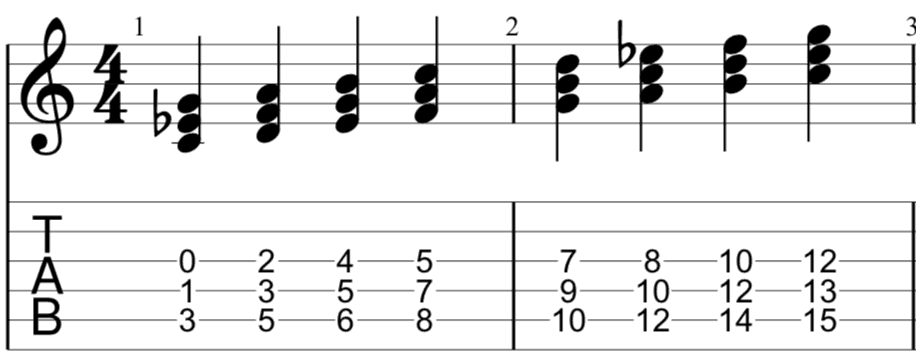
With that lowered 3rd (Eb), here’s what we end up with:
I – C Eb G – C minor
ii – D F A – D minor
iii – Eb G B – Eb Augmented
IV – F A C – F Major
V – G B D – G Major
vi – A C Eb – Am (b5)
vii – B D F – B diminished
..wow, that one note really changes some things right?
First, let’s look at what has stayed the same:
ii – D minor
IV – F Major
V- G Major
vii – B Diminished
These 4 chords exist in both C Major and C Melodic minor.
Now let’s look at what has changed:
- C Major becomes C minor
- E minor becomes Eb Augmented. That’s a big change!
- A minor becomes A minor with a lowered 5th.
Now let’s harmonize one more chord tone and add some 7th’s and see what we get:

Melodic Minor Chords
Results:
I – C Eb G B – C minor/Maj7
ii – D F A C – Dm7
iii – Eb G B D – Eb Maj7#5
IV – F A C Eb – F7
V – G B D F – G7
vi – A C Eb G – Am7b5
vii – B D F A – Bm7b5
- Once again the ii, V and vii chords remain unchanged but the F Maj7 now becomes an F Dominant 7.
- The ii chord remains D minor 7 and we get 2 pairs each of consecutive dominant 7ths and m7b5s.
You might be asking.. ok great now what can I do with all of this information?
If you’re not familiar with these shapes or how to create your own shapes, take a look at my Guitar Chords & Theory Article for a crash course in all things Chord related.Melodic Minor ‘Inside’ Usage
The obvious usage for Melodic minor would be to just play it over any of the chords above. This will a yield a cool new sound you can add to your improvisations.
Grab your looper or a backing track and try playing some melodic minor shapes over some chord progressions.
Let’s start with this recording this one:
Cm – F7 – G7 – G7
It sounds different right? .. but not bad and certainly not “outside”. All of the notes in those 3 chords exist within the C Melodic minor scale so you really can’t hit a bad note.
Melodic Minor Backing Track
Now try using all of the C Melodic minor shapes above over this backing track:
Melodic Minor as an “Altered” Scale.
First, let’s take a crash course in Altered Chords. you’ve probably played some and I’m certain you’ve heard of them.. but what exactly are we talking about here?
Think of your typical Dominant 7 chord, for example G7:
1 G
3 B
5 D
b7 F
Adding in a #5, b5, #9, b9 makes this an “altered chord”
Some examples:
G7#5 = GBD#F
G7b9 = G B D F Ab
Remember that “Jimi Hendrix Chord” you learned when you first picked up the guitar? Thats a Dominant 7#9.
In G That would be G7#9 = G B D F A#
You’ll see altered chords in just about every genre of music but most commonly in Jazz progressions.
I could write an entire book on just this topic, but for the sake of this lesson let’s just take a few widely used examples of how we can use Melodic minor over some altered chords:
“Up a 4th”
C Melodic Minor over G7 (or G7 altered #5,b5,#9,b9)
Record yourself playing a G7 vamp on your looper or grab a G7 backing track.
Play Melodic minor “Up a 4th” from G –
1 G
2 A
3 B
4 C Melodic minor
Let’s look at the C Melodic Minor scale as it would relate to a G7 chord:
C – 4th or 11th
D – 5th
Eb -#5 (altered sound)
F – b7
G – Root
A – 9th
B – 3rd
Pretty nice match up right? A good set of chord tones including some Jazzy extensions like the 11th and #5.
“Down a Whole Step”
Another common Melodic Minor usage in improvisation is to play “Down a Whole Step”, in this case, F Melodic Minor:
F Melodic Minor:
F G Ab Bb C D E F
In relation to that same G7 chord we can analyze it like this:
F – b7
G – Root
Ab – b9 (altered sound)
Bb – #9 (altered sound)
C – 4th or 11th
D – 5th
E – 6th or 13th
Wow.. now we got us some meat and potatoes!
We’re going to get some really cool altered dominant sounds with this usage. Try some others too, like “Up A 5th”, “Up a 1/2 Step”.. the possibilities are endless!
Melodic Minor Scale 3 Notes Per String Shapes
If you’re more of a modern player and already familiar with more efficient 3 note per string scales and modes, you might like these shapes best. Don’t let the funny names scare you. The names are just an explanation of the scale formula as it renters to its root degree parent Major scale. For example:
Ionian b3 – Is a Major scale with a flat 3rd.
Lydian Dominant – A #4 with a lowered 7th (Dominant 7th)
Here’s a Melodic Minor Scale PDF for Guitar in the Key of C Melodic minor.
Heres another PDF with just the C Melodic Minor Roots marked like this example below:

Melodic-minor-scales-guitar C
Craig Smith is a professional Guitarist, Teacher, and Writer living in Sanford, Florida. Craig has taught guitar lessons, performed 200+ gigs per year for nearly 30 years, and published 4 guitar instructional books. When he’s not gigging or writing, you may find him by the pool with his wife Celeste, 4 Chihuahuas, and a drink. 🎸

